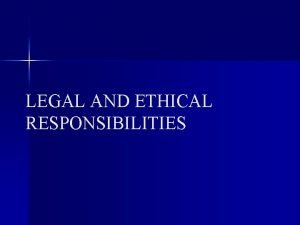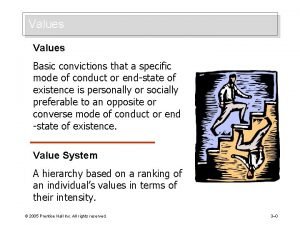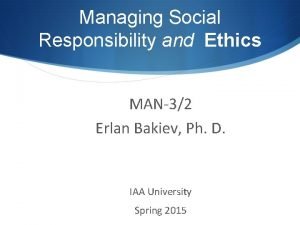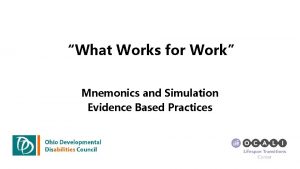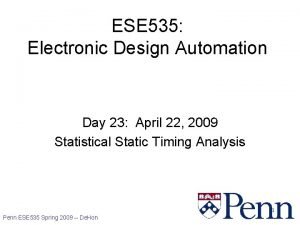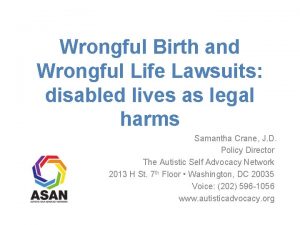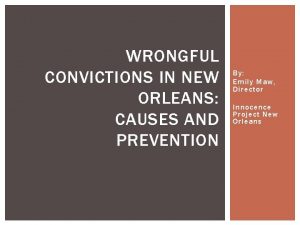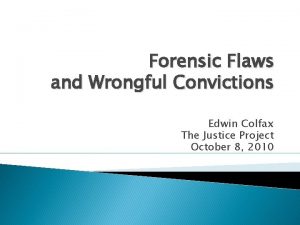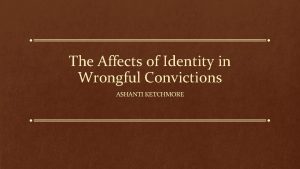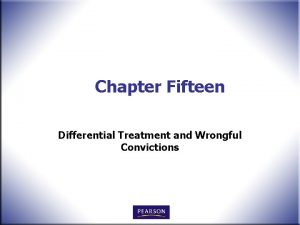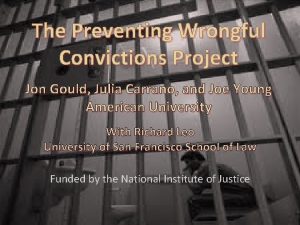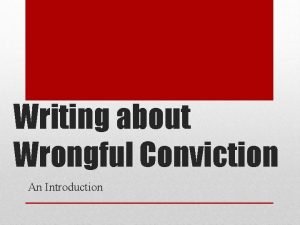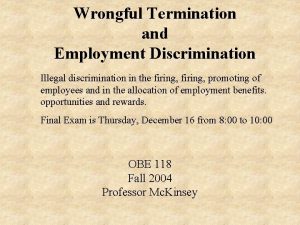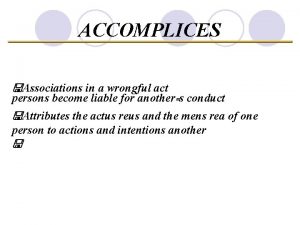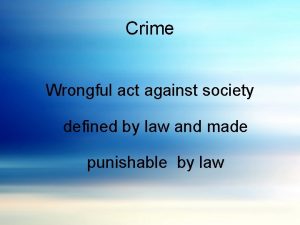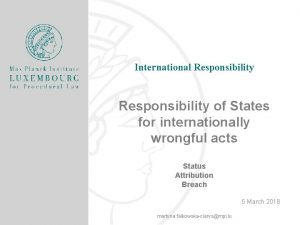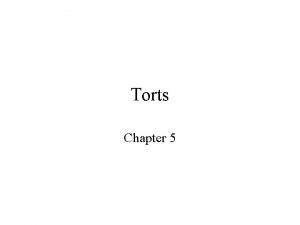WRONGFUL CONVICTIONS Who Why How As of April

































- Slides: 33

WRONGFUL CONVICTIONS Who? Why? How?


As of April 2015 there are 95 cases currently under review in Canada. The Association in Defence of the Wrongly Convicted (AIDWYC) have taken on 13 cases, providing legal review and counsel. The remaining 82 are still being assessed.

AIDWYC is a Canadian non-profit organization, based in Toronto, funded by donations and fund-raising, whose only function is to advocate for the purpose of exonerating people of serious crimes they did not commit. The work of the lawyers and legal researchers is done on a pro bono basis. It has been estimated that AIDWYC’s volunteer case reviewers contribute approximately $3, 500, 000 in pro bono work to the review of cases

Although AIDWYC launched the nd Proclamation of October 2 as Wrongful Conviction Day in 2014, they have done it to bring the world’s attention to this serious concern and to encourage the support of innocence agencies, advocacy groups and lawyers world wide.

AIDWYC is a member of the Innocence Network which has locations in Canada, United States, United Kingdom, Australia, France, New Zealand Ireland.

In addition to the many non -profit agencies that assist individuals to prove their innocence, there are countless individual lawyers who have also provided help. However not all legal assistance has

been pro-bono. Many people have paid thousands of dollars at the beginning of their court case, only to have to pay thousands of dollars later to prove their innocence.


Who? Everybody - you and I

Often marginalized, socially inept, functionally challenged persons; persons with criminal backgrounds; persons with substance or alcohol abuse problems; different culture or race; people who can be easily intimidated.

Romeo Phillion

Romeo Phillion had a history of criminal behaviour, various offences. In August 1967, an Ottawa firefighter had been stabbed to death; his widow was asked to identify several people including Romeo, in a line up but was unable to do so. At later dates she was called again to identify the person who killed her husband; over a period of time she identified three men all incorrectly. Four and a half years later, Romeo was picked up for another offence and charged with murder. Through a series of interviews, he eventually signed a confession. Years later, it surfaced Romeo had an alibi, he had been observed at a service station in Trenton two hours prior to the death of the fireman, therefore he could not have committed the crime. In spite of many appeals to clear his name, Romeo remained in prison 31 years.

Leighton Hay

Leighton Hay was 19 when he was picked up and charged, along with a second man, in relation to a shooting at a nightclub in Toronto, 2002. The victim died. Eyewitnesses said one of the men had 2 inch picky dreadlocks, which was longer hair than Leighton had. Leighton maintained he was not at the club that night. At the time of Leighton’s arrest, police found hair clippings in the sink which the Crown said proved he had cut his hair after the incident. Later forensic tests determined the hair was from his face and not his head. Leighton remained in prison for 12 years. He was released in November 2014. Much of his prison time was passed in the Ontario Regional Treatment Centre, Kingston Penitentiary. He has schizophrenia, which was exacerbated during his time in prison. The prison chaplain at the RTC said he was very pleased with the news of Leighton’s release. Leighton always demonstrated care and concern for the other inmates and regularly attended worship services.

Ahmed Mohamed

Ahmed Mohamed, age 14, was arrested and detained September 14 because of the homemade clock he had made and took to school. His teacher and other adults mistook it for a bomb. The current tension around race and religious differences can lead to similar over-reactive occurrences. Fortunately for Ahmed, no charges were laid. He has been invited to the White House to attend an astronomy night event next month. Mark Zuckerman has also invited him to visit his California-based company.

Why? Rush to solve case; faulty forensic evidence; false eyewitness reports; vindictive “victim”.

Tammy Marquardt

Tammy Marquardt was born in Toronto. Her father was Anishinabe and her mother of European descent; her parents separated. Tammy’s home life with her mother and stepfather was abusive so she left at age 17. At 19 her son Kenneth was born. Tammy married but this relationship was also chaotic. Kenneth suffered from several health issues and spent much of his early life in the hospital. One afternoon Tammy checked on Kenneth as he was sleeping but found he was tangled in his blanket and in distress with breathing problems.

An ambulance was called, CPR performed, Kenneth died three days later in the hospital. Dr. Charles Smith performed the autopsy and determined death was caused by smothering. Based on Dr. Smith’s findings, in 1993 Tammy was charged, convicted, sent to Grand Valley Penitentiary for women, where she remained until March 12, 2009. A new trial was to commence in February 2012 but prior to that date the Crown withdrew all charges against Tammy.

A rush to solve an investigation, a faulty forensics examination, false eye-witness testimony – can lead to a wrongful conviction. It is incumbent upon every person involved in the justice system to examine and re -examine each step along the process because at least one human life is involved. An incorrect judgement leads to the individual losing his or her freedom; their family may desert them; children may be put into foster care; there is loss of employment and good standing in the community; they become totally isolated from the world as they knew it. In many cases the individual loses not only their freedom but also their loved ones.

Wrongful convictions can also happen to people who are the pillers of their community; people of influence and good standing. No one is immune.

Ron Dalton

In 1988 Ron Dalton was a university educated bank manager in St. John’s, Newfoundland. One evening his wife started choking on some Harvest Crunch cereal she was eating. Ron tried to help her dislodge the food and called the ambulance. His wife died in hospital. Before the autopsy was complete the following day, Ron was arrested and charged, given a life sentence. He spent the next eight and a half years in prison. Ron was acquitted in 2000.

Ivstitia

Wrongful convictions result in the loss of freedom of the individual; a breakdown in family structure; loss of employment and standing in the community. They are a huge burden on the tax-payer – for the initial court trials and incarceration; followed by appeals and retrials; often followed by restitution in the hundreds of thousands or millions of dollars.

Wrongful convictions adversely affect victims who thought the perpetrator has been caught and sentenced accordingly; only to have to go through the whole painful process again, reopening old wounds. They thought they finally had closure in their lives but now there surfaces the question of who and where is the guilty person.

In some States, compensation is mandatory in wrongful conviction cases. If it was a mandatory payment in all wrongful convictions, perhaps more care would be taken in charging, convicting and sentencing innocent people. In the long run, this would save tax-payers hundreds of thousands of dollars each year. And reduce the number of family breakdowns.

John Artis

“I ask you - How much is one day in your life worth? ” This is the question John Artis asked each person present at the launch of Wrongful Conviction Day, October 2 nd, 2014 in Toronto. He was locked up for 15 years – 5, 478 days – 180 months – 780 weeks. It is hard to put a value on those lost days. John was co-accused with Rubin “Hurricane” Carter in 1967, Patterson, NJ for a triple homicide – simply because they were black and seemed to fit the eyewitness description. John spent 15 years in prison, Rubin 19. Their story is immortalized in the movie “The Hurricane”, a Norman Jewison production and in Bob Dylan’s song “Hurricane”.

Jamie Nelson – Struggle for Justice

In the mid 1990 s Jamie was accused and convicted of a crime he did not commit. It was a case of “he said” “she said” and the court believed the woman’s story. Jamie was incarcerated for 3. 5 years, 16 months of it was passed in segregation. Over the course of this time, police eventually became suspicious of similar charges the woman made against other men. All of the charges were false; Jamie’s case was reviewed. He was released in 1999. He appealed his case and in 2001 his conviction was overturned. His story is documented in “Jamie Nelson- Struggle for Justice” which has been viewed in over 100 countries.
 Wrongful acts that do not involve contracts
Wrongful acts that do not involve contracts Basic convictions that a specific mode of conduct
Basic convictions that a specific mode of conduct Socioeconomic view
Socioeconomic view Why why why why
Why why why why Why is april a busy month for birds
Why is april a busy month for birds Dont ask
Dont ask When was william shakespeare born and died
When was william shakespeare born and died 23.4.1616
23.4.1616 30 days has september april june and november
30 days has september april june and november April school activities
April school activities 26 april 1564
26 april 1564 April savoy allstate
April savoy allstate Sabbath day calendar
Sabbath day calendar Vårmåneder
Vårmåneder April rustianto
April rustianto Leonardo da vinci was born on april 15 1452 in vinci italy
Leonardo da vinci was born on april 15 1452 in vinci italy Leonardo da vini
Leonardo da vini Reformdjp/quiz/kuis-mini-reformasi-perpajakan-mei-2022
Reformdjp/quiz/kuis-mini-reformasi-perpajakan-mei-2022 Calendar april 2009
Calendar april 2009 Guten morgen freitag 1 april
Guten morgen freitag 1 april April bjornsen
April bjornsen 1889 april 20
1889 april 20 535 days before 23 april
535 days before 23 april April ericsson
April ericsson Dreißig tage hat september
Dreißig tage hat september Januar februar märz
Januar februar märz 1986 april 26
1986 april 26 Paula hurlock birthday
Paula hurlock birthday How to read p
How to read p Bondservants motorcycle
Bondservants motorcycle 20 april 1889
20 april 1889 Spengel's travel agency
Spengel's travel agency 22 april is celebrated as
22 april is celebrated as School calendar 2005-2006
School calendar 2005-2006
